Art World
Stanley Whitney Doesn’t Like to Look Back, Even on the Eve of His First-Ever Retrospective
The 77-year-old abstractionist is the subject of a major career spanning survey that just opened at the Buffalo AKG Art Museum.
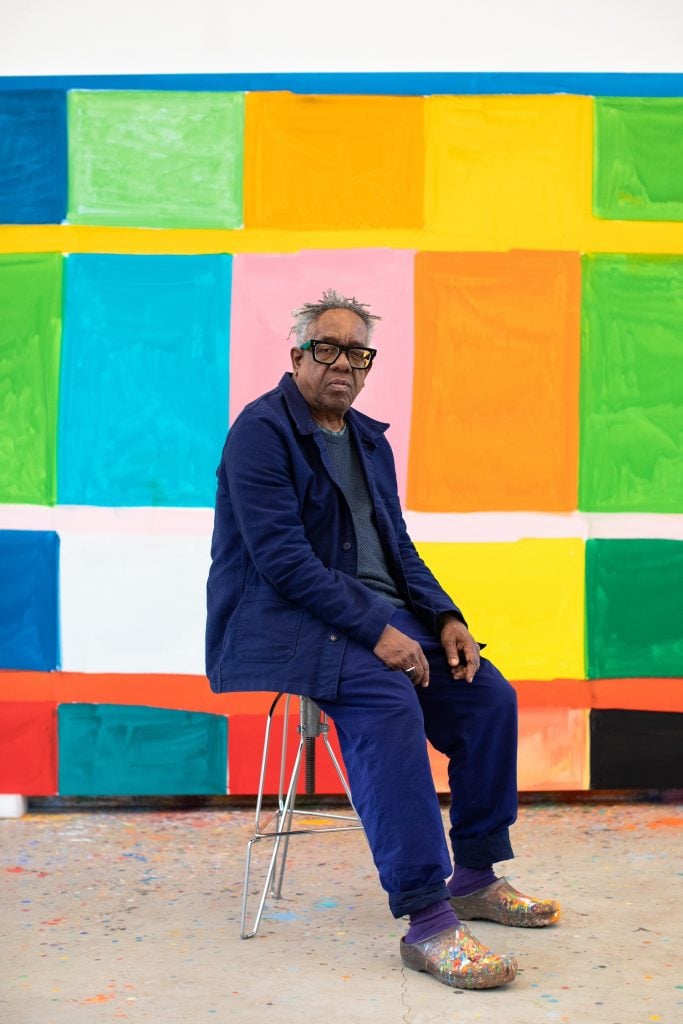
Lists of great artists often begin with rule breakers and revolutionaries—people like Duchamp, Pollock, and, Warhol who changed art by zagging from its traditions. Stanley Whitney belongs among these names, but he’s no revolutionary. The 77-year-old abstractionist has, after all, spent the last two decades of his career painting variations of the same square, gridded image. For all his achievements, Whitney has never been one to reinvent the wheel.
This fact is a central theme of the artist’s first-ever retrospective, “How High the Moon,” which just opened at the Buffalo AKG Art Museum in Western New York. While many career-spanning surveys measure their subjects’ success on scales weighted toward progress and innovation, this show highlights an artist who prevailed on different terms. A snippet of wall text two-thirds of the way in sums it up nicely: “Whitney has made paintings that are not about getting somewhere but about laboring to find where we are.”
That’s no small feat.
“He’s among the greatest living American painters, without question,” said AKG chief curator, Cathleen Chaffee, who organized the retrospective. She isn’t alone in this opinion; in recent years, critics and journalists have not been shy about foisting lofty superlatives on the artist. At this point, it seems, his status as a master is almost a foregone conclusion.
That wasn’t always the case though, and it’s damaging to pretend otherwise. Whitney himself has a complicated relationship with past chapters of his career, many defined by a lack of attention and commercial success. It’s partly why he first expressed misgivings about the idea of a retrospective when Chaffee pitched it to him five years ago.
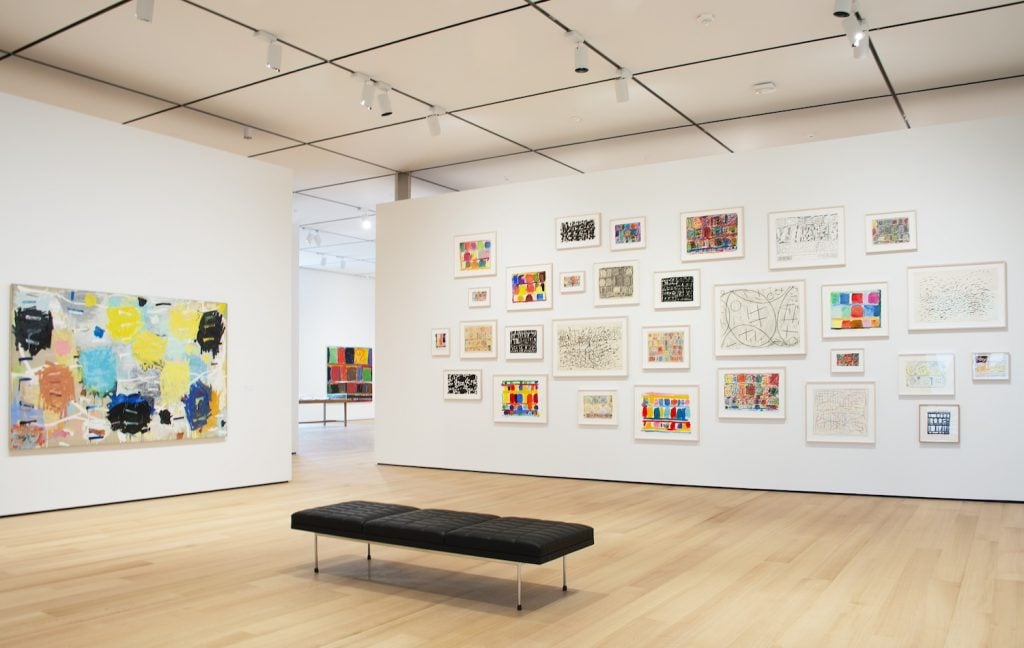
Installation view, “Stanley Whitney: How High the Moon” at Buffalo AKG. Courtesy of Buffalo AKG.
“It’s a very weird thing for artists to do, I think, because you’re trying to move forward and people are dragging you back,” he told me during an interview a few days ahead of the show’s opening. There was still some hesitancy in his voice on the topic, even though, by that point, five decade’s worth of his work had already been installed on the museum’s walls. “It’s wonderful in one sense, but at the same time I’m trying to move to the future.”
As he spoke, the artist was sitting in his Bridgehampton, New York studio, his face framed by a pair of chunky, blockish glasses that recalled the wayward rectangles of his work. Whitney’s insistence on moving forward is is good news for his fans, but to hear him hear him preach a focus on the future is a little surprising. For one thing, when it comes to other areas of his practice, he doesn’t seem that interested in change.
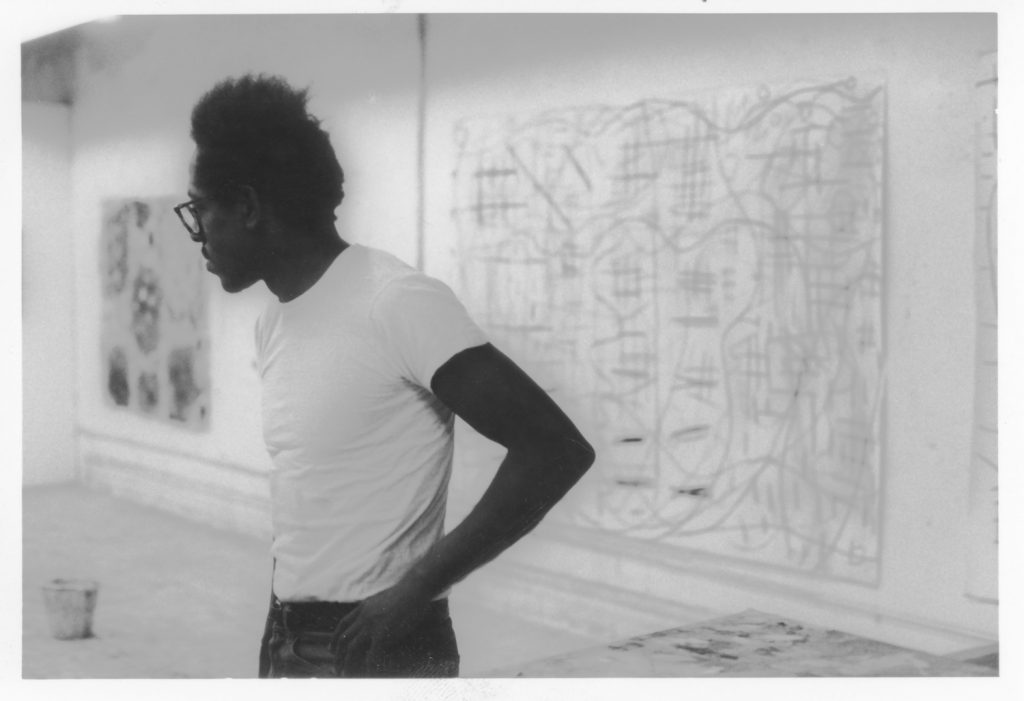
Stanley Whitney in his studio at Cooper Square, ca. 1980–82. Photo: Courtesy of Stanley Whitney Studio.
When working, Whitney always listens to the same record: Miles Davis’s landmark 1970 fusion album, Bitches Brew. He also begins every painting the same way: with single, long brush stroke that spans the canvas’s top edge. Then comes the rows of colored blocks, added one by one, left to right, a patchwork checkerboard. The resultant network of rectangles situates within a long lineage of grid-painters, from Piet Mondrian to Josef Albers to Agnes Martin. Though while these artists favored hard lines and geometric precision, Whitney’s forms are more like cubes of Jello: always wiggling.
“How High the Moon” takes its title from the 1940 jazz standard of the same name. The song has been reinterpreted countless times, but it was an improvisatory 1960 cover by Ella Fitzgerald that clicked for Whitney after months of batting around title ideas with Chafee. Recorded live in Berlin, the song starts slowly, then revs up into a virtuosic climax that finds Fitzgerald breathlessly quoting some 40-plus songs—from nursery rhymes to “Flight of the Bumblebee”—in the span of three minutes.
Chaffee was quick to clock a linkage between Fitzgerald’s litany of references and Whitney’s own capacity for compressing history into a package all his own. “Like the song,” she wrote in an essay for the “How High the Moon” catalogue, “this exhibition is a story that begins with newness and innovation; it continues with iteration and variation: an artist attenuating, stretching, and improvising on his source, quoting others and himself, making a standard new again, and again, and again.”
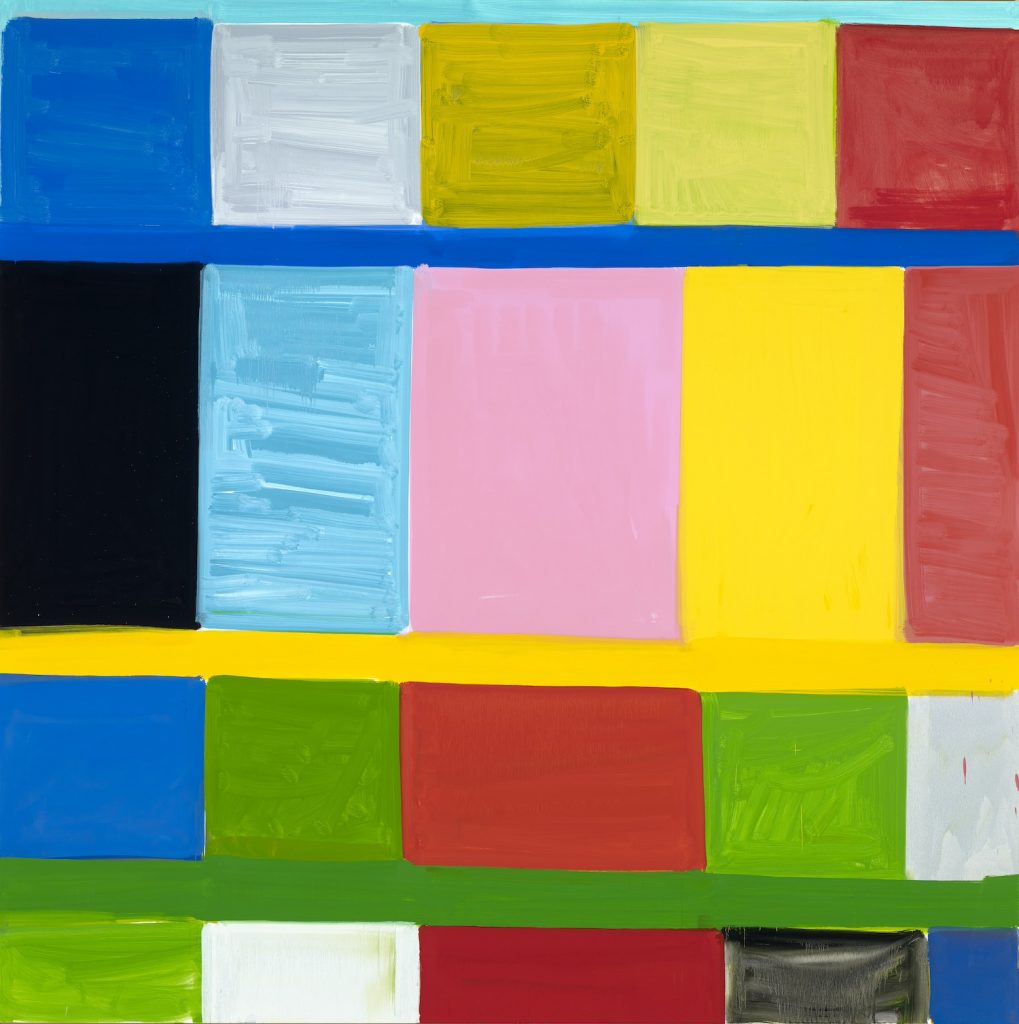
Stanley Whitney, Endless Time (2017), Collection Buffalo AKG Art Museum. Bequest of Arthur B. Michael, by exchange, 2017 (2017:21). © Stanley Whitney. Photo: Tom Loonan and Brenda Bieger, Buffalo AKG Art Museum.
For Whitney, the title is personal—the Fitzgerald record was one of his mother’s favorites—but also evocative. “I liked the idea of reaching for something,” he said plainly. The sentiment seemed simple, but the tone of his response, and the brief pause that followed, left me wondering whether he viewed the “moon” as a metaphor for aspiration or a symbol for the elusiveness of success. Later, I realized it was both.
***
Titles are of great significance in Whitney’s practice, and yet they rarely come easy. He never starts a painting with a title in mind, but rather waits for one to come to him after the piece is completed. Sometimes an artwork will go months or even years before Whitney knows what to call it. It’s hard, he explained, to “name something that you don’t recognize. You can’t name something that you don’t know.”
It says a lot about Whitney’s career that almost all of the works in the first half of the chronologically installed show are “untitled.” This group includes his earliest effort on view, a 1972 painting of broad, wormy strokes that the artist finished upon wrapping graduate school at Yale. At Al Held’s suggestion, Whitney used a mop to apply the paint in this particular artwork, and while it doesn’t have much in common with the gridded compositions for which he would come to be known, it does capture both the restless experimentation of his Yale years and the sense of social alienation that defined them. Unable to afford an apartment, Whitney lived in his studio during grad school; he said he only got away with it because administrators assumed he was a maintenance worker.
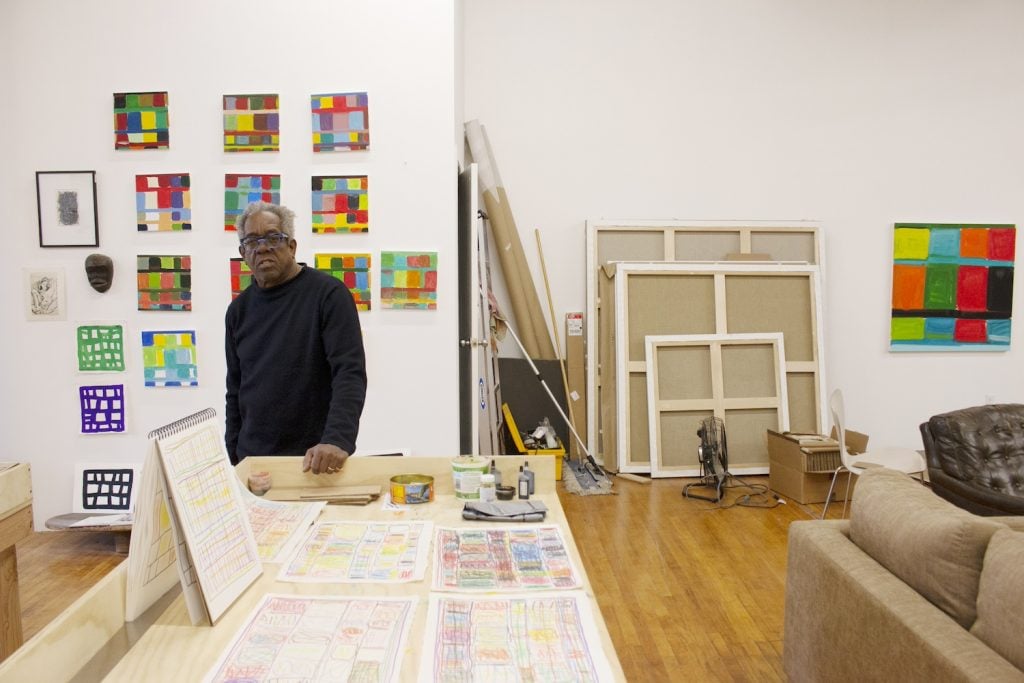
Stanley Whitney in his studio, Ridgewood, Queens, 2017. Photo: Katherine McMahon
Whitney was proud of Untitled, but also frustrated by it. “He felt it was both like a beginning and a dead end,” Chaffee explained. “It was a success,” and yet, he “couldn’t figure out how to make more like it.”
It wasn’t the only time Whitney would struggle with that problem. After Yale, the artist spent nearly 20 years juggling jobs and struggling to make magic in his New York studio. Like Rothko, Newman, and other mid-century giants before him, Whitney was after what he called his “signature painting”—that is, a style that was fresh and urgent and unmistakably his own. “He was always trying to do something new that worked, that was an innovation,” Chaffee explained.
But that signature painting didn’t come; nor did commercial success. Like so many Black artists of his generation—including his acquaintances Jack Whitten and Barkley Hendricks—Whitney worked without recognition for a long time. The grind took a toll, and by 1990, when a New York solo show with dealer Jose Freire closed without a single sale, the artist decided it was time for An opportunity to teach in Rome came up, and he and his wife—fellow artist Marina Adams—jumped on it.
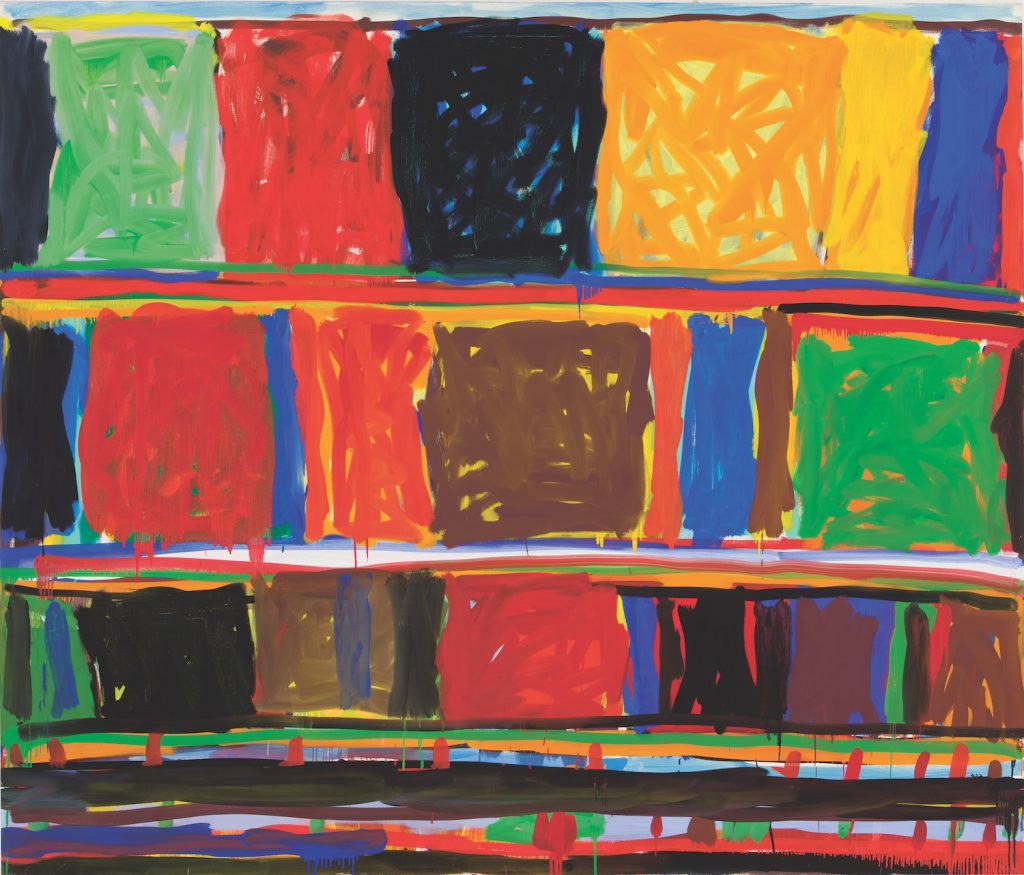
Stanley Whitney, Color Bar (1997). Private Collection. © Stanley Whitney. Photo: Courtesy of Stanley Whitney Studio.
Whitney’s mutli-year stint in Italy, and the pilgrimage to Egypt he made halfway through, would come to have a transformative on his work. Rome’s Colosseum, Pantheon, and other Classical landmarks inspired him to consider composition with an architect’s eye, while the Great Pyramids of Giza had him rethinking the nature of density. Before that trip, Whitney said he thought in terms of space and color. “But in Egypt I realized that the space was in the color. That was a big shift. Once I realized that… I felt like I could make my paintings.”
For years, Whitney pushed his practice forward in search of a signature painting. He finally found it by looking back to some of the oldest structures on Earth. Not coincidentally, it was around this time that he began consistently titling his work too.
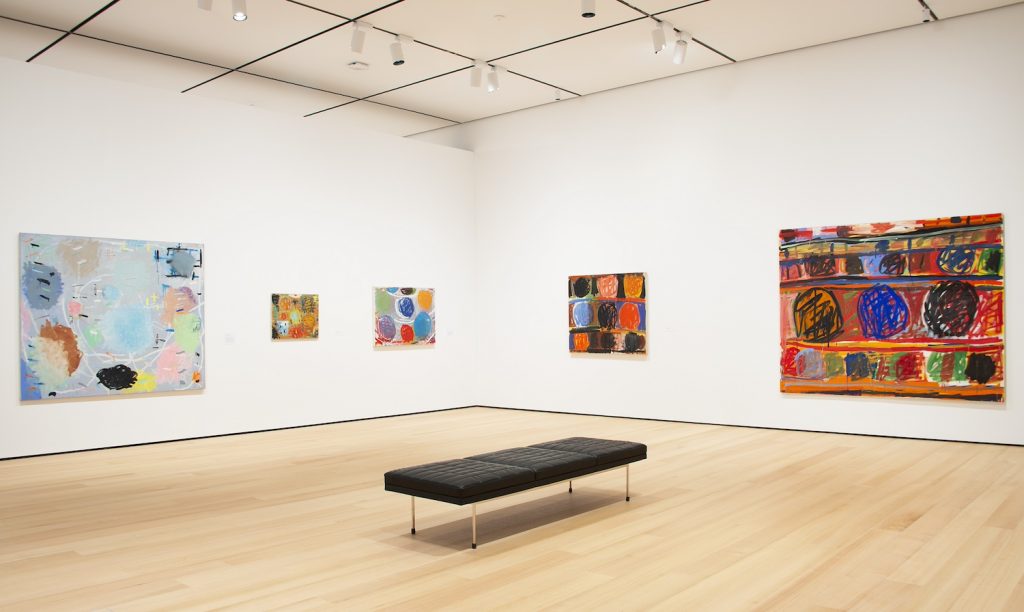
Installation view, “Stanley Whitney: How High the Moon” at Buffalo AKG. Courtesy of Buffalo AKG.
Commercial success was slow to follow, but it did come eventually. After returning to the states, Whitney had a series of shows at Nordenhake, Bill Maynes Gallery, Esso Gallery, Christine König Galerie, and Team Gallery. In 2015, he mounted a critically acclaimed exhibition of recent works at the Studio Museum in Harlem and joined Lisson Gallery. By the time he switched over to Gagosian in 2022 (he continues to be represented by Nordenhake), the artist’s paintings were selling for six figures. Several have fetched millions at auction since.
With all of Whitney’s recent—and much deserved—success, it’s easy to forgot just how new it is. The best thing about the AKG retrospective is that it doesn’t make this mistake. More than celebrate the achievements of the artist’s work, it honors the sweat he put into it—including and especially during all those years when no one was paying attention. Whitney may not like looking back to his past, but it’s important that the rest of us do.
Near the end of our conversation, I put a hypothetical question in front of Whitney: “If someone had told you at the beginning of your career that it would take decades for you to come into your own as an artist—and even longer for people to start paying attention—would you still go on the journey?” He didn’t miss a beat.
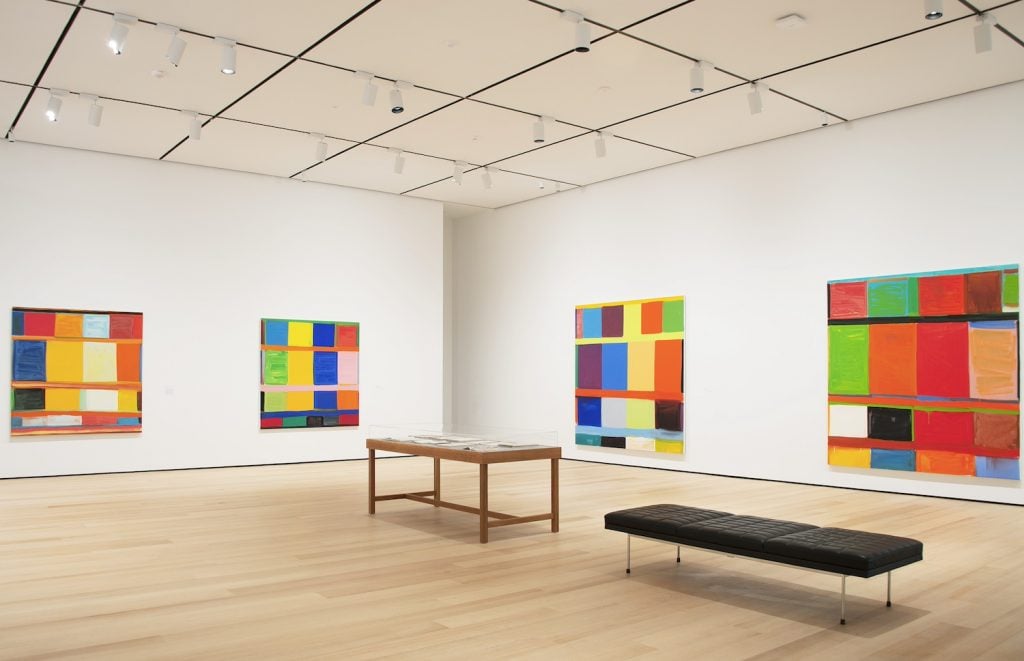
Installation view, “Stanley Whitney: How High the Moon” at Buffalo AKG. Courtesy of Buffalo AKG.
“I would have done it no matter what,” he said. “I didn’t do it thinking I’d have success ever. In fact, when people come up to me now and treat me like I’m successful, I’m always really shocked,” he said with a hearty laugh. For Whitney, it is and has always been “about the work.”
“That’s what it’s all about. So that’s what you do. You do the work no matter what. And if my success stopped or people didn’t buy the work I would still be making the same work. I would still do it.”
“Stanley Whitney: How High the Moon” is on view now through May 26, 2024, at the Buffalo AKG Art Museum. The retrospective will travel to Walker Art Center (11/14/24–03/16/25) and ICA/Boston (04/17/25–09/01/25)





